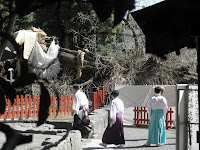


March 12, 2010
Kamakura shrine loses symbolic tree
Kamakura shrine loses symbolic tree
A famous Shinto shrine in Kamakura, the home to Japan’s first samurai-led regime, was filled with a mixed atmosphere one day this week. Visitors were heaving a sigh of admiration at early cherry blossoms at several places in the precincts of Tsurugaoka Hachimangu Shrine, while others were watching a fallen ginkgo tree near the main building of the shrine with worried faces. The news that the 800-year-old, 30-meter-high tree had fallen has attracted an unusually large number of visitors to the shrine. (Readers may be advised to see the post published on Jan. 7.)
Tsurugaoka Hachimangu attracts about half of some 19 million tourists to Kamakura. After the incident, shrine priests held a rite in front of the tree to calm and purify its soul. The ginkgo tree, which had shed its leaves, was uprooted by a storm before dawn on Wednesday. A watchman at the shrine heard big sounds a few times before finding the tree lying beneath the big staircase leading to the main building with its root totally exposed. The incident came as a shock to frequent visitors and worshipers to the shrine as well as citizens of Kamakura, because the tree has been admired as the symbol of the shrine.
“We will resuscitate the tree while obtaining experts’ advice,” a shrine official said. “We’ll have to do so anyway, because it has been a sacred tree for us,” he said. An expert who was called to the shrine and took a look at the situation said it will be difficult to plant the tree back at the same place.
Tsurugaoka Hachimangu attracts about half of some 19 million tourists to Kamakura. After the incident, shrine priests held a rite in front of the tree to calm and purify its soul. The ginkgo tree, which had shed its leaves, was uprooted by a storm before dawn on Wednesday. A watchman at the shrine heard big sounds a few times before finding the tree lying beneath the big staircase leading to the main building with its root totally exposed. The incident came as a shock to frequent visitors and worshipers to the shrine as well as citizens of Kamakura, because the tree has been admired as the symbol of the shrine.
“We will resuscitate the tree while obtaining experts’ advice,” a shrine official said. “We’ll have to do so anyway, because it has been a sacred tree for us,” he said. An expert who was called to the shrine and took a look at the situation said it will be difficult to plant the tree back at the same place.
The tree, with its trunk 6.8 meters around, is linked to a legend about the 1219 assassination of Minamoto Sanetomo, the third and last Kamakura shogun. Sanetomo, a son of the first Kamakura shogun Minamoto Yoritomo, was 26 when he was assassinated by his nephew on a snowy day at the shrine. He was also known as a waka poet. One of his works in his own waka poem anthology goes:
This world would be unchanged forever, I wish.
A fisherman is seen ahead
rowing a small boat
tied to a rope extended from the beach.
What an interesting view it is!
(A personal translation)
With its root covered by straw mats, the tree was surrounded by hundreds of people standing with a worried look behind the fences. An old man said, “I feel sad about it, because my wife and I had a wedding ceremony at this shrine 50 years ago.”
The tree has been designated as a natural monument for Kanagawa Prefecture. Kanagawa Governor Shigefumi Matsuzawa expects to establish a task force to discuss what to do about the tree. Japanese people are busy making their living amid concern about the course of the economy, but the incident suggests that people are rather having stronger interest in Japan’s culture and tradition. The year 2010 should be remembered as an important year not just for the shrine but also for those who love Kamakura and its history.
The tree has been designated as a natural monument for Kanagawa Prefecture. Kanagawa Governor Shigefumi Matsuzawa expects to establish a task force to discuss what to do about the tree. Japanese people are busy making their living amid concern about the course of the economy, but the incident suggests that people are rather having stronger interest in Japan’s culture and tradition. The year 2010 should be remembered as an important year not just for the shrine but also for those who love Kamakura and its history.